Leadership in International Business: Strengths, Stretches, and Goals
VerifiedAdded on 2022/10/18
|11
|2879
|6
Presentation
AI Summary
This presentation delves into the multifaceted realm of leadership within the context of international business. The vodcast explores the essential characteristics of effective global leaders, emphasizing the importance of cultural sensitivity, communication skills, and strategic thinking. It examines key concepts such as self-awareness, strategic thinking, and empathy, highlighting how these qualities contribute to building strong relationships and driving organizational success. The presentation further explores various leadership styles, including blue ocean leadership, and analyzes different leadership theories, such as trait, contingency, and situational theories. The presentation also addresses ethical leadership, decision-making methods, and the characteristics of system leaders and super bosses. Finally, the presentation focuses on level 5 leadership and explores how leaders can cultivate their strengths, address their underdeveloped competencies, and set goals for enhancing their leadership capabilities in a global environment, supported by the presenter's resume and professional experience.
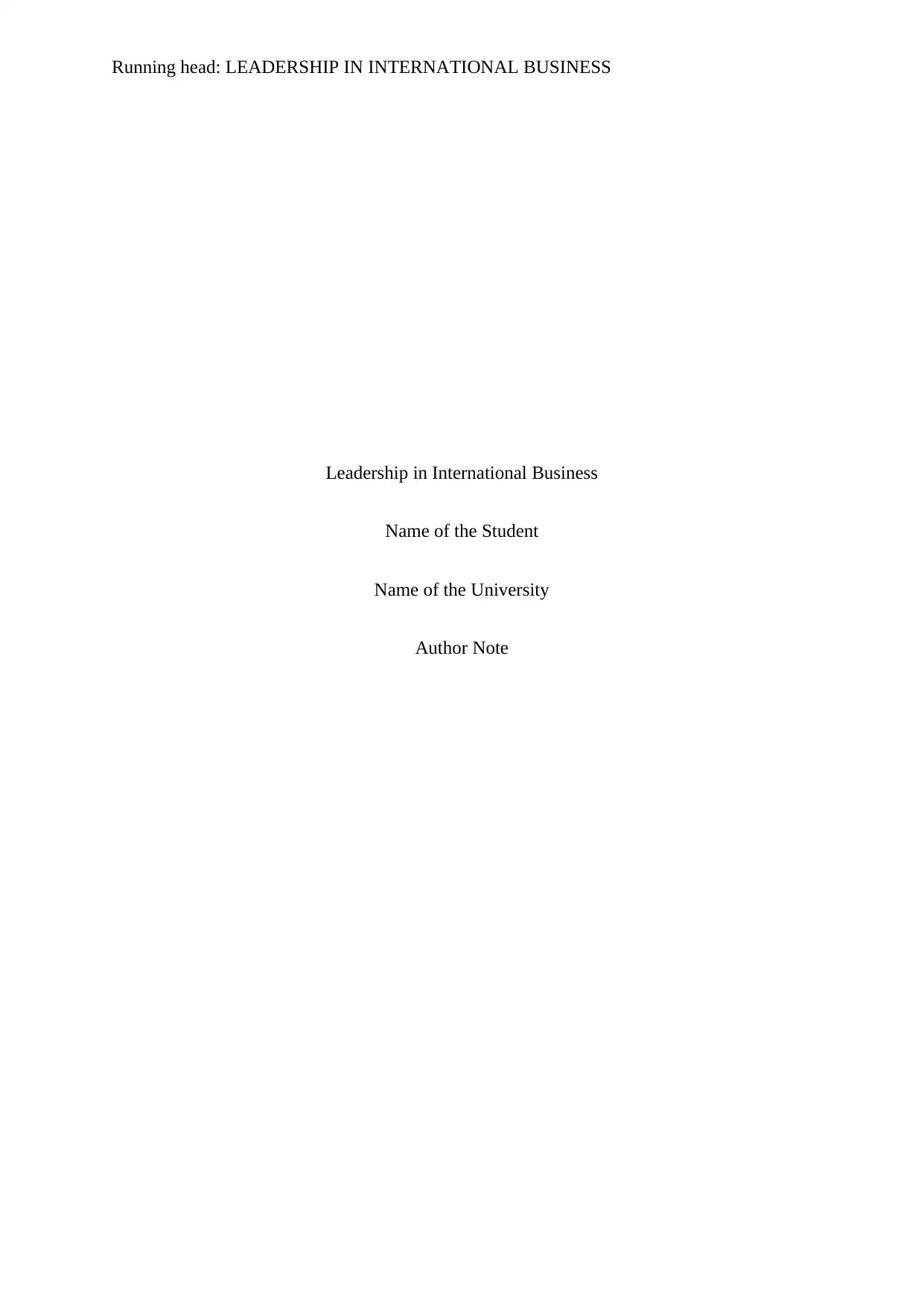
Running head: LEADERSHIP IN INTERNATIONAL BUSINESS
Leadership in International Business
Name of the Student
Name of the University
Author Note
Leadership in International Business
Name of the Student
Name of the University
Author Note
Paraphrase This Document
Need a fresh take? Get an instant paraphrase of this document with our AI Paraphraser
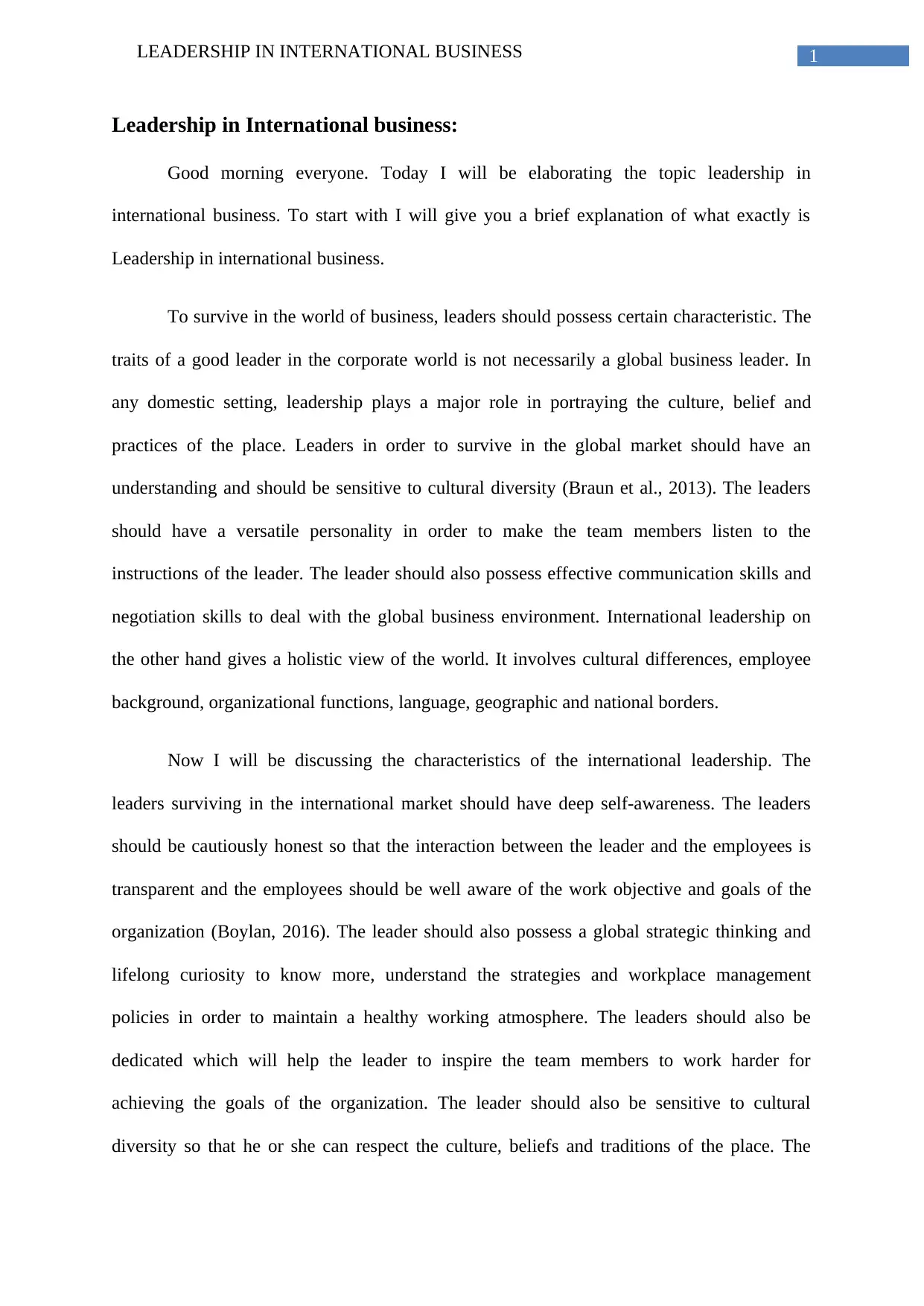
1LEADERSHIP IN INTERNATIONAL BUSINESS
Leadership in International business:
Good morning everyone. Today I will be elaborating the topic leadership in
international business. To start with I will give you a brief explanation of what exactly is
Leadership in international business.
To survive in the world of business, leaders should possess certain characteristic. The
traits of a good leader in the corporate world is not necessarily a global business leader. In
any domestic setting, leadership plays a major role in portraying the culture, belief and
practices of the place. Leaders in order to survive in the global market should have an
understanding and should be sensitive to cultural diversity (Braun et al., 2013). The leaders
should have a versatile personality in order to make the team members listen to the
instructions of the leader. The leader should also possess effective communication skills and
negotiation skills to deal with the global business environment. International leadership on
the other hand gives a holistic view of the world. It involves cultural differences, employee
background, organizational functions, language, geographic and national borders.
Now I will be discussing the characteristics of the international leadership. The
leaders surviving in the international market should have deep self-awareness. The leaders
should be cautiously honest so that the interaction between the leader and the employees is
transparent and the employees should be well aware of the work objective and goals of the
organization (Boylan, 2016). The leader should also possess a global strategic thinking and
lifelong curiosity to know more, understand the strategies and workplace management
policies in order to maintain a healthy working atmosphere. The leaders should also be
dedicated which will help the leader to inspire the team members to work harder for
achieving the goals of the organization. The leader should also be sensitive to cultural
diversity so that he or she can respect the culture, beliefs and traditions of the place. The
Leadership in International business:
Good morning everyone. Today I will be elaborating the topic leadership in
international business. To start with I will give you a brief explanation of what exactly is
Leadership in international business.
To survive in the world of business, leaders should possess certain characteristic. The
traits of a good leader in the corporate world is not necessarily a global business leader. In
any domestic setting, leadership plays a major role in portraying the culture, belief and
practices of the place. Leaders in order to survive in the global market should have an
understanding and should be sensitive to cultural diversity (Braun et al., 2013). The leaders
should have a versatile personality in order to make the team members listen to the
instructions of the leader. The leader should also possess effective communication skills and
negotiation skills to deal with the global business environment. International leadership on
the other hand gives a holistic view of the world. It involves cultural differences, employee
background, organizational functions, language, geographic and national borders.
Now I will be discussing the characteristics of the international leadership. The
leaders surviving in the international market should have deep self-awareness. The leaders
should be cautiously honest so that the interaction between the leader and the employees is
transparent and the employees should be well aware of the work objective and goals of the
organization (Boylan, 2016). The leader should also possess a global strategic thinking and
lifelong curiosity to know more, understand the strategies and workplace management
policies in order to maintain a healthy working atmosphere. The leaders should also be
dedicated which will help the leader to inspire the team members to work harder for
achieving the goals of the organization. The leader should also be sensitive to cultural
diversity so that he or she can respect the culture, beliefs and traditions of the place. The
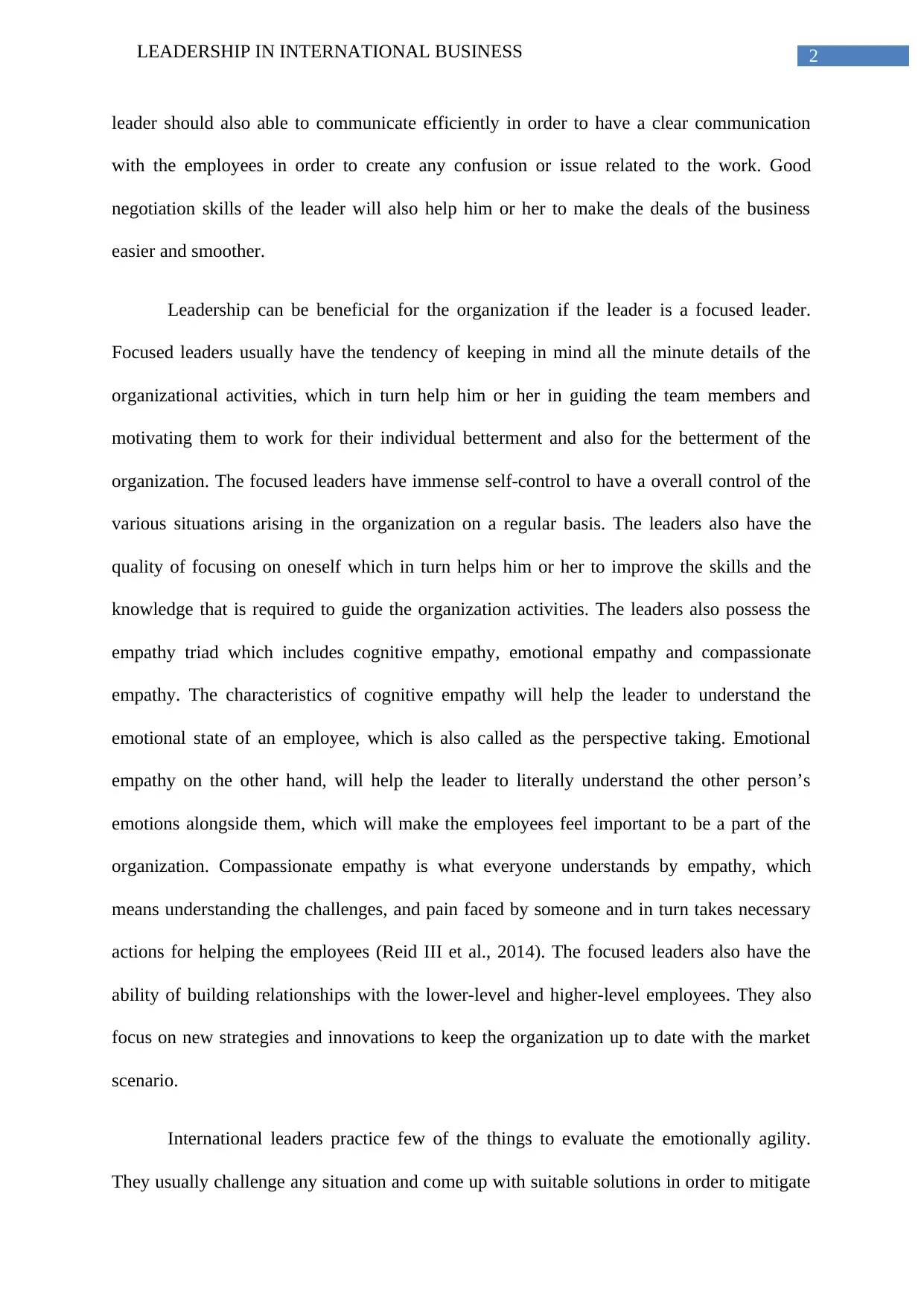
2LEADERSHIP IN INTERNATIONAL BUSINESS
leader should also able to communicate efficiently in order to have a clear communication
with the employees in order to create any confusion or issue related to the work. Good
negotiation skills of the leader will also help him or her to make the deals of the business
easier and smoother.
Leadership can be beneficial for the organization if the leader is a focused leader.
Focused leaders usually have the tendency of keeping in mind all the minute details of the
organizational activities, which in turn help him or her in guiding the team members and
motivating them to work for their individual betterment and also for the betterment of the
organization. The focused leaders have immense self-control to have a overall control of the
various situations arising in the organization on a regular basis. The leaders also have the
quality of focusing on oneself which in turn helps him or her to improve the skills and the
knowledge that is required to guide the organization activities. The leaders also possess the
empathy triad which includes cognitive empathy, emotional empathy and compassionate
empathy. The characteristics of cognitive empathy will help the leader to understand the
emotional state of an employee, which is also called as the perspective taking. Emotional
empathy on the other hand, will help the leader to literally understand the other person’s
emotions alongside them, which will make the employees feel important to be a part of the
organization. Compassionate empathy is what everyone understands by empathy, which
means understanding the challenges, and pain faced by someone and in turn takes necessary
actions for helping the employees (Reid III et al., 2014). The focused leaders also have the
ability of building relationships with the lower-level and higher-level employees. They also
focus on new strategies and innovations to keep the organization up to date with the market
scenario.
International leaders practice few of the things to evaluate the emotionally agility.
They usually challenge any situation and come up with suitable solutions in order to mitigate
leader should also able to communicate efficiently in order to have a clear communication
with the employees in order to create any confusion or issue related to the work. Good
negotiation skills of the leader will also help him or her to make the deals of the business
easier and smoother.
Leadership can be beneficial for the organization if the leader is a focused leader.
Focused leaders usually have the tendency of keeping in mind all the minute details of the
organizational activities, which in turn help him or her in guiding the team members and
motivating them to work for their individual betterment and also for the betterment of the
organization. The focused leaders have immense self-control to have a overall control of the
various situations arising in the organization on a regular basis. The leaders also have the
quality of focusing on oneself which in turn helps him or her to improve the skills and the
knowledge that is required to guide the organization activities. The leaders also possess the
empathy triad which includes cognitive empathy, emotional empathy and compassionate
empathy. The characteristics of cognitive empathy will help the leader to understand the
emotional state of an employee, which is also called as the perspective taking. Emotional
empathy on the other hand, will help the leader to literally understand the other person’s
emotions alongside them, which will make the employees feel important to be a part of the
organization. Compassionate empathy is what everyone understands by empathy, which
means understanding the challenges, and pain faced by someone and in turn takes necessary
actions for helping the employees (Reid III et al., 2014). The focused leaders also have the
ability of building relationships with the lower-level and higher-level employees. They also
focus on new strategies and innovations to keep the organization up to date with the market
scenario.
International leaders practice few of the things to evaluate the emotionally agility.
They usually challenge any situation and come up with suitable solutions in order to mitigate
⊘ This is a preview!⊘
Do you want full access?
Subscribe today to unlock all pages.

Trusted by 1+ million students worldwide
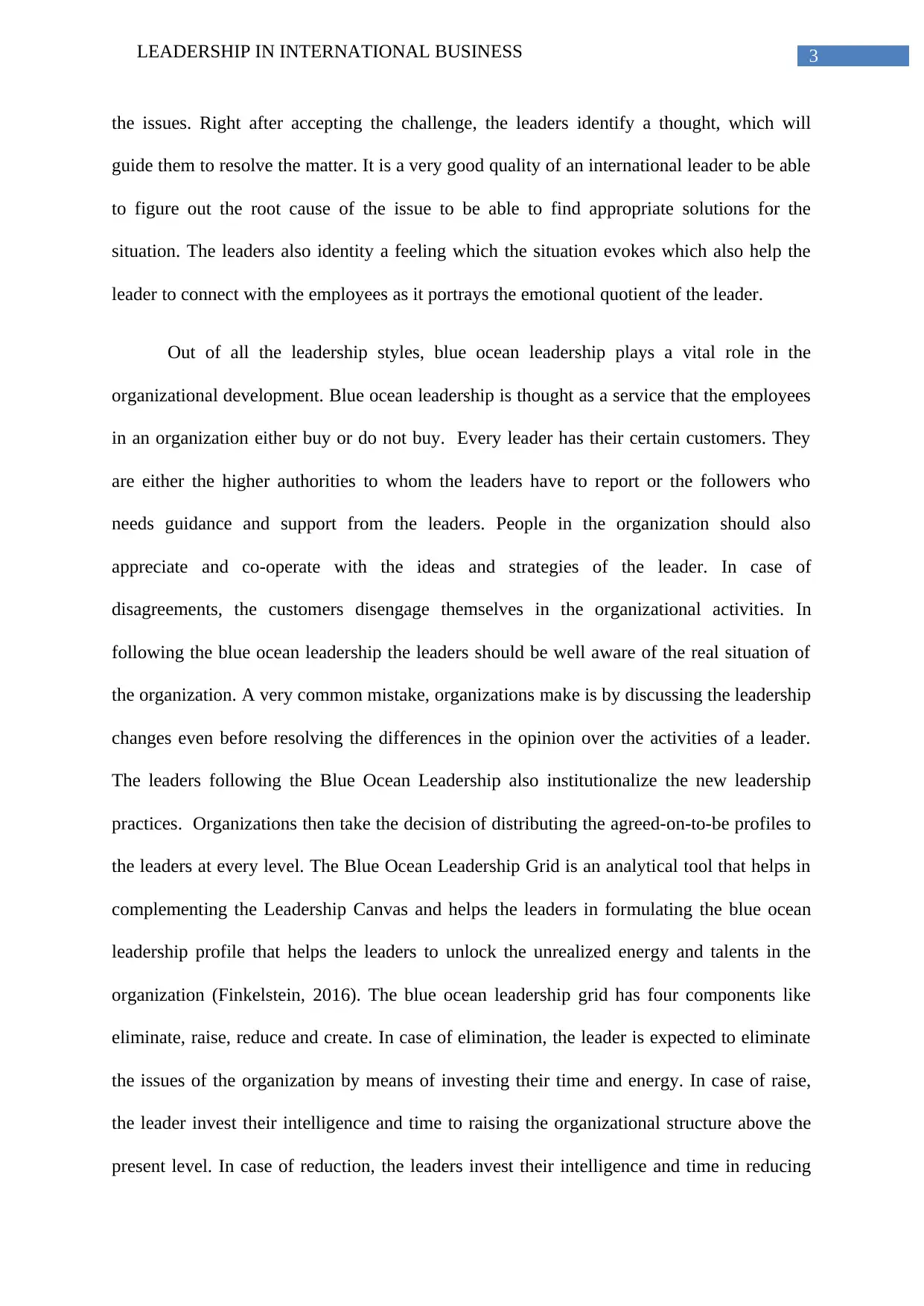
3LEADERSHIP IN INTERNATIONAL BUSINESS
the issues. Right after accepting the challenge, the leaders identify a thought, which will
guide them to resolve the matter. It is a very good quality of an international leader to be able
to figure out the root cause of the issue to be able to find appropriate solutions for the
situation. The leaders also identity a feeling which the situation evokes which also help the
leader to connect with the employees as it portrays the emotional quotient of the leader.
Out of all the leadership styles, blue ocean leadership plays a vital role in the
organizational development. Blue ocean leadership is thought as a service that the employees
in an organization either buy or do not buy. Every leader has their certain customers. They
are either the higher authorities to whom the leaders have to report or the followers who
needs guidance and support from the leaders. People in the organization should also
appreciate and co-operate with the ideas and strategies of the leader. In case of
disagreements, the customers disengage themselves in the organizational activities. In
following the blue ocean leadership the leaders should be well aware of the real situation of
the organization. A very common mistake, organizations make is by discussing the leadership
changes even before resolving the differences in the opinion over the activities of a leader.
The leaders following the Blue Ocean Leadership also institutionalize the new leadership
practices. Organizations then take the decision of distributing the agreed-on-to-be profiles to
the leaders at every level. The Blue Ocean Leadership Grid is an analytical tool that helps in
complementing the Leadership Canvas and helps the leaders in formulating the blue ocean
leadership profile that helps the leaders to unlock the unrealized energy and talents in the
organization (Finkelstein, 2016). The blue ocean leadership grid has four components like
eliminate, raise, reduce and create. In case of elimination, the leader is expected to eliminate
the issues of the organization by means of investing their time and energy. In case of raise,
the leader invest their intelligence and time to raising the organizational structure above the
present level. In case of reduction, the leaders invest their intelligence and time in reducing
the issues. Right after accepting the challenge, the leaders identify a thought, which will
guide them to resolve the matter. It is a very good quality of an international leader to be able
to figure out the root cause of the issue to be able to find appropriate solutions for the
situation. The leaders also identity a feeling which the situation evokes which also help the
leader to connect with the employees as it portrays the emotional quotient of the leader.
Out of all the leadership styles, blue ocean leadership plays a vital role in the
organizational development. Blue ocean leadership is thought as a service that the employees
in an organization either buy or do not buy. Every leader has their certain customers. They
are either the higher authorities to whom the leaders have to report or the followers who
needs guidance and support from the leaders. People in the organization should also
appreciate and co-operate with the ideas and strategies of the leader. In case of
disagreements, the customers disengage themselves in the organizational activities. In
following the blue ocean leadership the leaders should be well aware of the real situation of
the organization. A very common mistake, organizations make is by discussing the leadership
changes even before resolving the differences in the opinion over the activities of a leader.
The leaders following the Blue Ocean Leadership also institutionalize the new leadership
practices. Organizations then take the decision of distributing the agreed-on-to-be profiles to
the leaders at every level. The Blue Ocean Leadership Grid is an analytical tool that helps in
complementing the Leadership Canvas and helps the leaders in formulating the blue ocean
leadership profile that helps the leaders to unlock the unrealized energy and talents in the
organization (Finkelstein, 2016). The blue ocean leadership grid has four components like
eliminate, raise, reduce and create. In case of elimination, the leader is expected to eliminate
the issues of the organization by means of investing their time and energy. In case of raise,
the leader invest their intelligence and time to raising the organizational structure above the
present level. In case of reduction, the leaders invest their intelligence and time in reducing
Paraphrase This Document
Need a fresh take? Get an instant paraphrase of this document with our AI Paraphraser
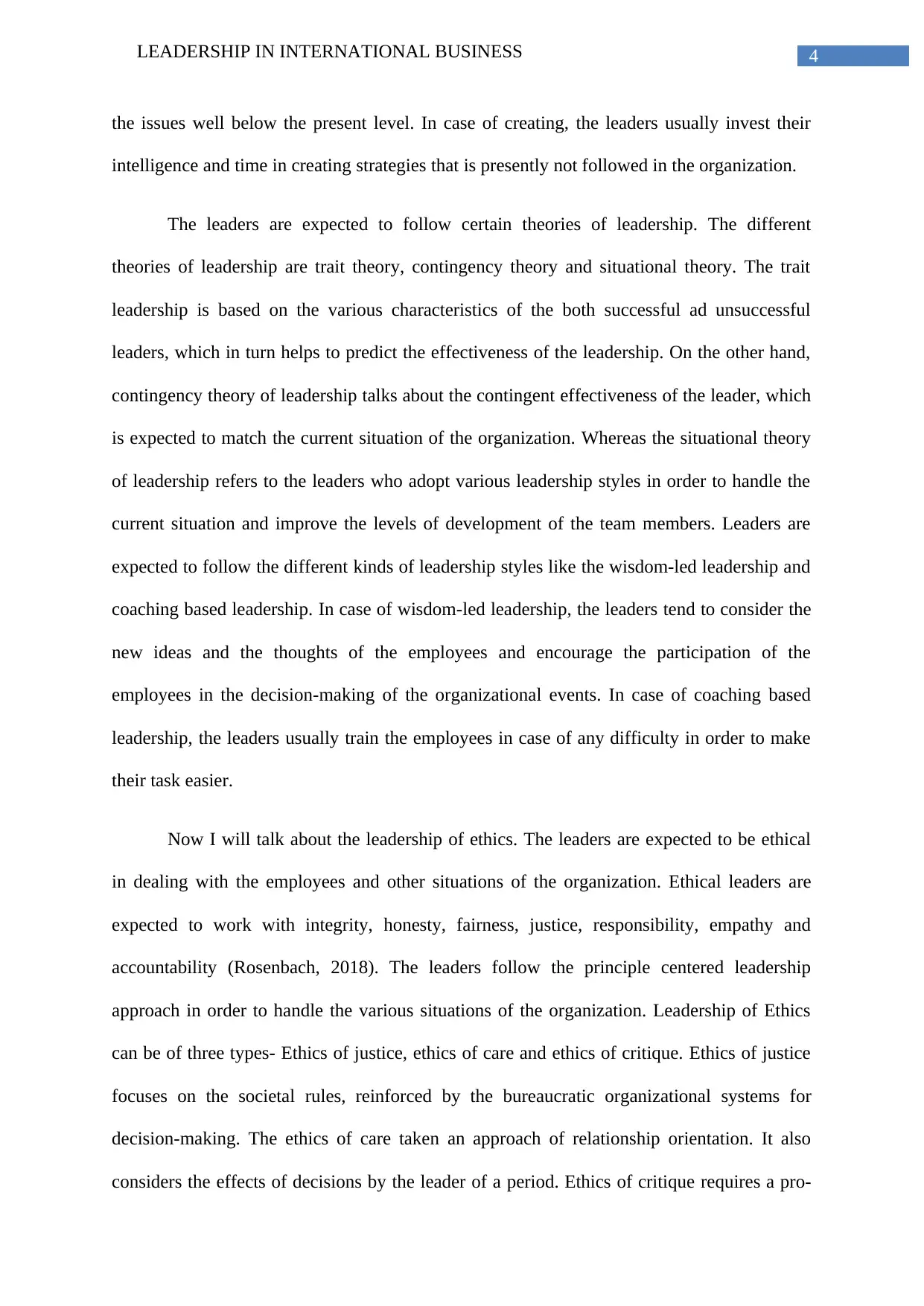
4LEADERSHIP IN INTERNATIONAL BUSINESS
the issues well below the present level. In case of creating, the leaders usually invest their
intelligence and time in creating strategies that is presently not followed in the organization.
The leaders are expected to follow certain theories of leadership. The different
theories of leadership are trait theory, contingency theory and situational theory. The trait
leadership is based on the various characteristics of the both successful ad unsuccessful
leaders, which in turn helps to predict the effectiveness of the leadership. On the other hand,
contingency theory of leadership talks about the contingent effectiveness of the leader, which
is expected to match the current situation of the organization. Whereas the situational theory
of leadership refers to the leaders who adopt various leadership styles in order to handle the
current situation and improve the levels of development of the team members. Leaders are
expected to follow the different kinds of leadership styles like the wisdom-led leadership and
coaching based leadership. In case of wisdom-led leadership, the leaders tend to consider the
new ideas and the thoughts of the employees and encourage the participation of the
employees in the decision-making of the organizational events. In case of coaching based
leadership, the leaders usually train the employees in case of any difficulty in order to make
their task easier.
Now I will talk about the leadership of ethics. The leaders are expected to be ethical
in dealing with the employees and other situations of the organization. Ethical leaders are
expected to work with integrity, honesty, fairness, justice, responsibility, empathy and
accountability (Rosenbach, 2018). The leaders follow the principle centered leadership
approach in order to handle the various situations of the organization. Leadership of Ethics
can be of three types- Ethics of justice, ethics of care and ethics of critique. Ethics of justice
focuses on the societal rules, reinforced by the bureaucratic organizational systems for
decision-making. The ethics of care taken an approach of relationship orientation. It also
considers the effects of decisions by the leader of a period. Ethics of critique requires a pro-
the issues well below the present level. In case of creating, the leaders usually invest their
intelligence and time in creating strategies that is presently not followed in the organization.
The leaders are expected to follow certain theories of leadership. The different
theories of leadership are trait theory, contingency theory and situational theory. The trait
leadership is based on the various characteristics of the both successful ad unsuccessful
leaders, which in turn helps to predict the effectiveness of the leadership. On the other hand,
contingency theory of leadership talks about the contingent effectiveness of the leader, which
is expected to match the current situation of the organization. Whereas the situational theory
of leadership refers to the leaders who adopt various leadership styles in order to handle the
current situation and improve the levels of development of the team members. Leaders are
expected to follow the different kinds of leadership styles like the wisdom-led leadership and
coaching based leadership. In case of wisdom-led leadership, the leaders tend to consider the
new ideas and the thoughts of the employees and encourage the participation of the
employees in the decision-making of the organizational events. In case of coaching based
leadership, the leaders usually train the employees in case of any difficulty in order to make
their task easier.
Now I will talk about the leadership of ethics. The leaders are expected to be ethical
in dealing with the employees and other situations of the organization. Ethical leaders are
expected to work with integrity, honesty, fairness, justice, responsibility, empathy and
accountability (Rosenbach, 2018). The leaders follow the principle centered leadership
approach in order to handle the various situations of the organization. Leadership of Ethics
can be of three types- Ethics of justice, ethics of care and ethics of critique. Ethics of justice
focuses on the societal rules, reinforced by the bureaucratic organizational systems for
decision-making. The ethics of care taken an approach of relationship orientation. It also
considers the effects of decisions by the leader of a period. Ethics of critique requires a pro-
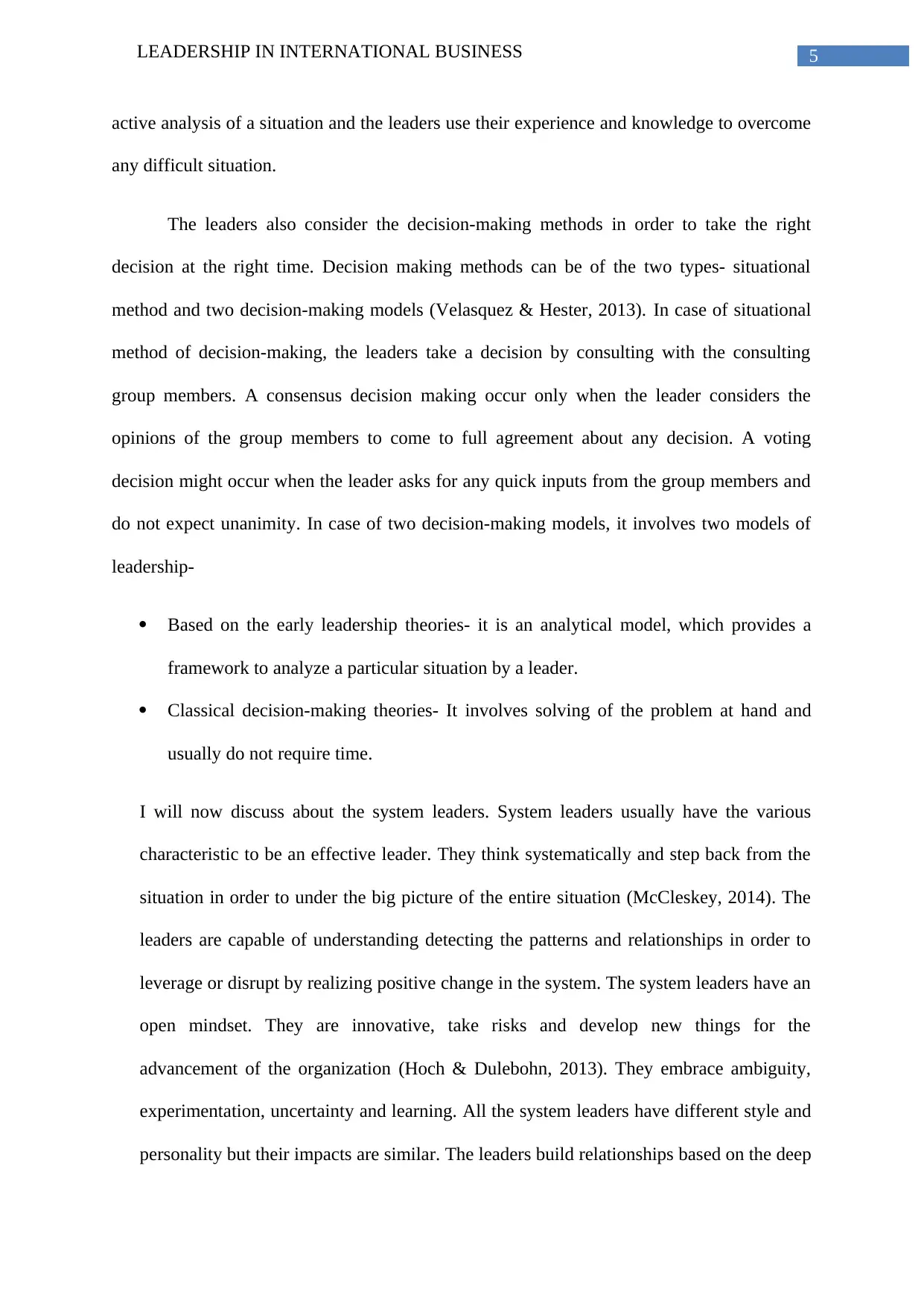
5LEADERSHIP IN INTERNATIONAL BUSINESS
active analysis of a situation and the leaders use their experience and knowledge to overcome
any difficult situation.
The leaders also consider the decision-making methods in order to take the right
decision at the right time. Decision making methods can be of the two types- situational
method and two decision-making models (Velasquez & Hester, 2013). In case of situational
method of decision-making, the leaders take a decision by consulting with the consulting
group members. A consensus decision making occur only when the leader considers the
opinions of the group members to come to full agreement about any decision. A voting
decision might occur when the leader asks for any quick inputs from the group members and
do not expect unanimity. In case of two decision-making models, it involves two models of
leadership-
Based on the early leadership theories- it is an analytical model, which provides a
framework to analyze a particular situation by a leader.
Classical decision-making theories- It involves solving of the problem at hand and
usually do not require time.
I will now discuss about the system leaders. System leaders usually have the various
characteristic to be an effective leader. They think systematically and step back from the
situation in order to under the big picture of the entire situation (McCleskey, 2014). The
leaders are capable of understanding detecting the patterns and relationships in order to
leverage or disrupt by realizing positive change in the system. The system leaders have an
open mindset. They are innovative, take risks and develop new things for the
advancement of the organization (Hoch & Dulebohn, 2013). They embrace ambiguity,
experimentation, uncertainty and learning. All the system leaders have different style and
personality but their impacts are similar. The leaders build relationships based on the deep
active analysis of a situation and the leaders use their experience and knowledge to overcome
any difficult situation.
The leaders also consider the decision-making methods in order to take the right
decision at the right time. Decision making methods can be of the two types- situational
method and two decision-making models (Velasquez & Hester, 2013). In case of situational
method of decision-making, the leaders take a decision by consulting with the consulting
group members. A consensus decision making occur only when the leader considers the
opinions of the group members to come to full agreement about any decision. A voting
decision might occur when the leader asks for any quick inputs from the group members and
do not expect unanimity. In case of two decision-making models, it involves two models of
leadership-
Based on the early leadership theories- it is an analytical model, which provides a
framework to analyze a particular situation by a leader.
Classical decision-making theories- It involves solving of the problem at hand and
usually do not require time.
I will now discuss about the system leaders. System leaders usually have the various
characteristic to be an effective leader. They think systematically and step back from the
situation in order to under the big picture of the entire situation (McCleskey, 2014). The
leaders are capable of understanding detecting the patterns and relationships in order to
leverage or disrupt by realizing positive change in the system. The system leaders have an
open mindset. They are innovative, take risks and develop new things for the
advancement of the organization (Hoch & Dulebohn, 2013). They embrace ambiguity,
experimentation, uncertainty and learning. All the system leaders have different style and
personality but their impacts are similar. The leaders build relationships based on the deep
⊘ This is a preview!⊘
Do you want full access?
Subscribe today to unlock all pages.

Trusted by 1+ million students worldwide
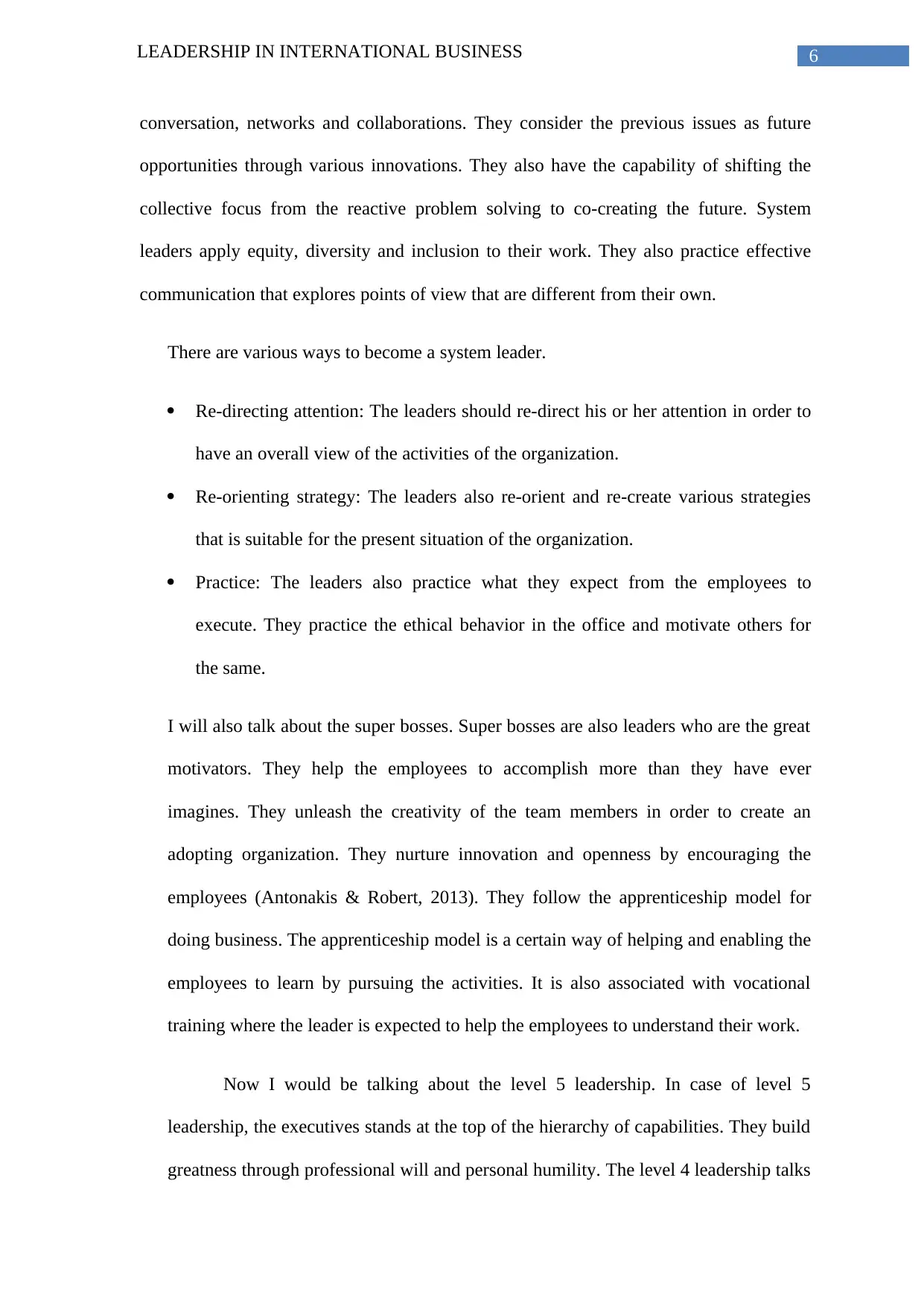
6LEADERSHIP IN INTERNATIONAL BUSINESS
conversation, networks and collaborations. They consider the previous issues as future
opportunities through various innovations. They also have the capability of shifting the
collective focus from the reactive problem solving to co-creating the future. System
leaders apply equity, diversity and inclusion to their work. They also practice effective
communication that explores points of view that are different from their own.
There are various ways to become a system leader.
Re-directing attention: The leaders should re-direct his or her attention in order to
have an overall view of the activities of the organization.
Re-orienting strategy: The leaders also re-orient and re-create various strategies
that is suitable for the present situation of the organization.
Practice: The leaders also practice what they expect from the employees to
execute. They practice the ethical behavior in the office and motivate others for
the same.
I will also talk about the super bosses. Super bosses are also leaders who are the great
motivators. They help the employees to accomplish more than they have ever
imagines. They unleash the creativity of the team members in order to create an
adopting organization. They nurture innovation and openness by encouraging the
employees (Antonakis & Robert, 2013). They follow the apprenticeship model for
doing business. The apprenticeship model is a certain way of helping and enabling the
employees to learn by pursuing the activities. It is also associated with vocational
training where the leader is expected to help the employees to understand their work.
Now I would be talking about the level 5 leadership. In case of level 5
leadership, the executives stands at the top of the hierarchy of capabilities. They build
greatness through professional will and personal humility. The level 4 leadership talks
conversation, networks and collaborations. They consider the previous issues as future
opportunities through various innovations. They also have the capability of shifting the
collective focus from the reactive problem solving to co-creating the future. System
leaders apply equity, diversity and inclusion to their work. They also practice effective
communication that explores points of view that are different from their own.
There are various ways to become a system leader.
Re-directing attention: The leaders should re-direct his or her attention in order to
have an overall view of the activities of the organization.
Re-orienting strategy: The leaders also re-orient and re-create various strategies
that is suitable for the present situation of the organization.
Practice: The leaders also practice what they expect from the employees to
execute. They practice the ethical behavior in the office and motivate others for
the same.
I will also talk about the super bosses. Super bosses are also leaders who are the great
motivators. They help the employees to accomplish more than they have ever
imagines. They unleash the creativity of the team members in order to create an
adopting organization. They nurture innovation and openness by encouraging the
employees (Antonakis & Robert, 2013). They follow the apprenticeship model for
doing business. The apprenticeship model is a certain way of helping and enabling the
employees to learn by pursuing the activities. It is also associated with vocational
training where the leader is expected to help the employees to understand their work.
Now I would be talking about the level 5 leadership. In case of level 5
leadership, the executives stands at the top of the hierarchy of capabilities. They build
greatness through professional will and personal humility. The level 4 leadership talks
Paraphrase This Document
Need a fresh take? Get an instant paraphrase of this document with our AI Paraphraser
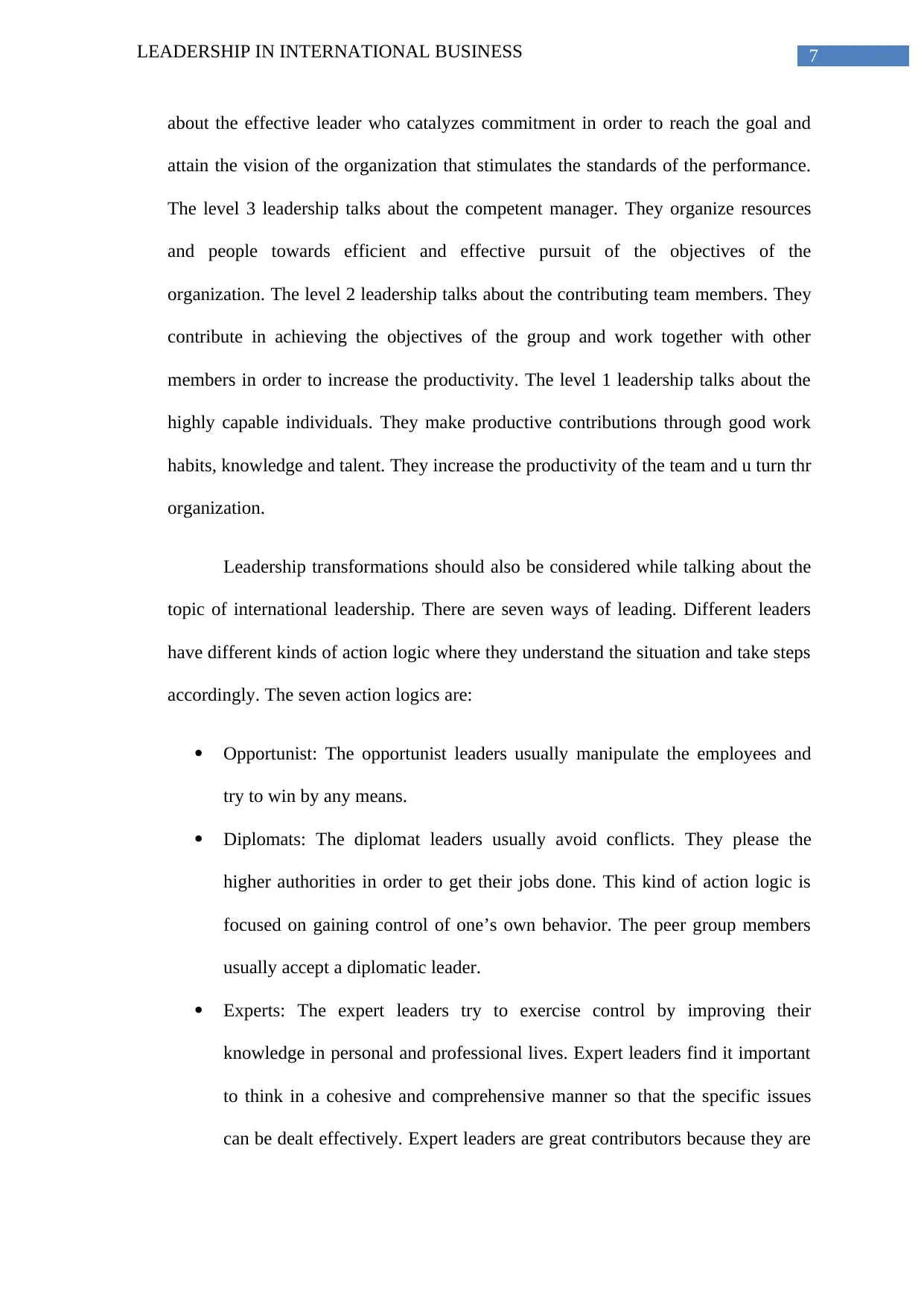
7LEADERSHIP IN INTERNATIONAL BUSINESS
about the effective leader who catalyzes commitment in order to reach the goal and
attain the vision of the organization that stimulates the standards of the performance.
The level 3 leadership talks about the competent manager. They organize resources
and people towards efficient and effective pursuit of the objectives of the
organization. The level 2 leadership talks about the contributing team members. They
contribute in achieving the objectives of the group and work together with other
members in order to increase the productivity. The level 1 leadership talks about the
highly capable individuals. They make productive contributions through good work
habits, knowledge and talent. They increase the productivity of the team and u turn thr
organization.
Leadership transformations should also be considered while talking about the
topic of international leadership. There are seven ways of leading. Different leaders
have different kinds of action logic where they understand the situation and take steps
accordingly. The seven action logics are:
Opportunist: The opportunist leaders usually manipulate the employees and
try to win by any means.
Diplomats: The diplomat leaders usually avoid conflicts. They please the
higher authorities in order to get their jobs done. This kind of action logic is
focused on gaining control of one’s own behavior. The peer group members
usually accept a diplomatic leader.
Experts: The expert leaders try to exercise control by improving their
knowledge in personal and professional lives. Expert leaders find it important
to think in a cohesive and comprehensive manner so that the specific issues
can be dealt effectively. Expert leaders are great contributors because they are
about the effective leader who catalyzes commitment in order to reach the goal and
attain the vision of the organization that stimulates the standards of the performance.
The level 3 leadership talks about the competent manager. They organize resources
and people towards efficient and effective pursuit of the objectives of the
organization. The level 2 leadership talks about the contributing team members. They
contribute in achieving the objectives of the group and work together with other
members in order to increase the productivity. The level 1 leadership talks about the
highly capable individuals. They make productive contributions through good work
habits, knowledge and talent. They increase the productivity of the team and u turn thr
organization.
Leadership transformations should also be considered while talking about the
topic of international leadership. There are seven ways of leading. Different leaders
have different kinds of action logic where they understand the situation and take steps
accordingly. The seven action logics are:
Opportunist: The opportunist leaders usually manipulate the employees and
try to win by any means.
Diplomats: The diplomat leaders usually avoid conflicts. They please the
higher authorities in order to get their jobs done. This kind of action logic is
focused on gaining control of one’s own behavior. The peer group members
usually accept a diplomatic leader.
Experts: The expert leaders try to exercise control by improving their
knowledge in personal and professional lives. Expert leaders find it important
to think in a cohesive and comprehensive manner so that the specific issues
can be dealt effectively. Expert leaders are great contributors because they are
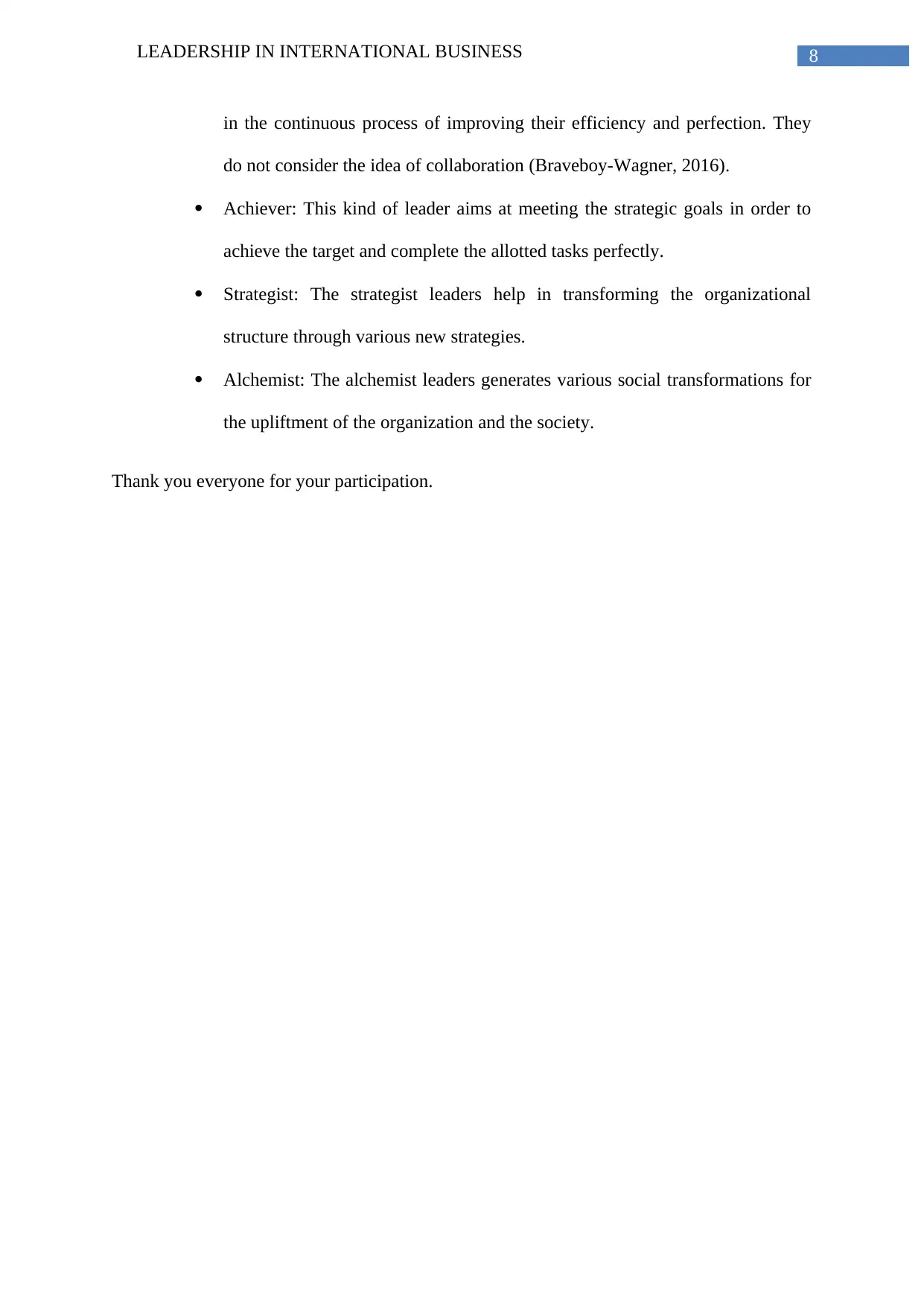
8LEADERSHIP IN INTERNATIONAL BUSINESS
in the continuous process of improving their efficiency and perfection. They
do not consider the idea of collaboration (Braveboy-Wagner, 2016).
Achiever: This kind of leader aims at meeting the strategic goals in order to
achieve the target and complete the allotted tasks perfectly.
Strategist: The strategist leaders help in transforming the organizational
structure through various new strategies.
Alchemist: The alchemist leaders generates various social transformations for
the upliftment of the organization and the society.
Thank you everyone for your participation.
in the continuous process of improving their efficiency and perfection. They
do not consider the idea of collaboration (Braveboy-Wagner, 2016).
Achiever: This kind of leader aims at meeting the strategic goals in order to
achieve the target and complete the allotted tasks perfectly.
Strategist: The strategist leaders help in transforming the organizational
structure through various new strategies.
Alchemist: The alchemist leaders generates various social transformations for
the upliftment of the organization and the society.
Thank you everyone for your participation.
⊘ This is a preview!⊘
Do you want full access?
Subscribe today to unlock all pages.

Trusted by 1+ million students worldwide
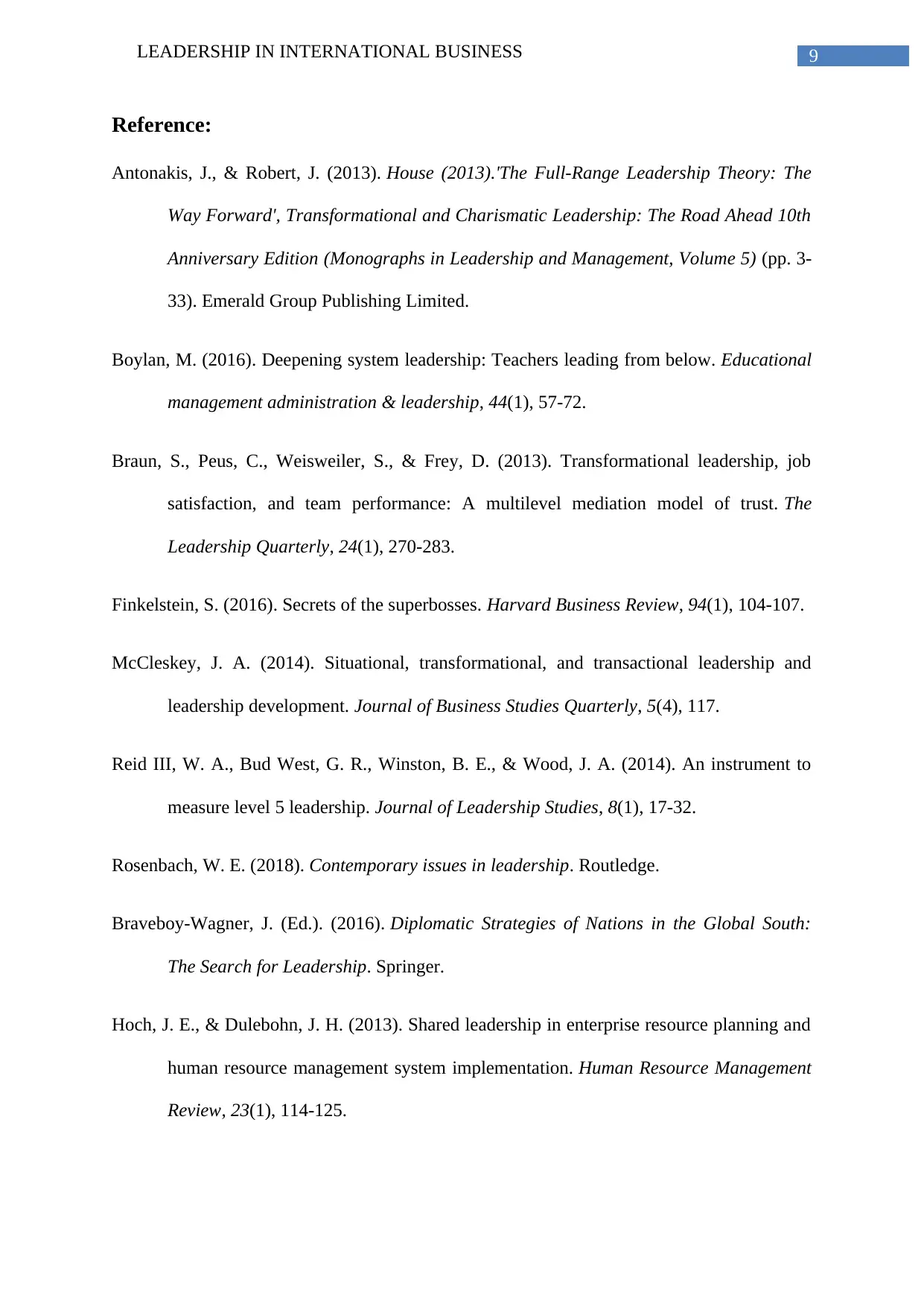
9LEADERSHIP IN INTERNATIONAL BUSINESS
Reference:
Antonakis, J., & Robert, J. (2013). House (2013).'The Full-Range Leadership Theory: The
Way Forward', Transformational and Charismatic Leadership: The Road Ahead 10th
Anniversary Edition (Monographs in Leadership and Management, Volume 5) (pp. 3-
33). Emerald Group Publishing Limited.
Boylan, M. (2016). Deepening system leadership: Teachers leading from below. Educational
management administration & leadership, 44(1), 57-72.
Braun, S., Peus, C., Weisweiler, S., & Frey, D. (2013). Transformational leadership, job
satisfaction, and team performance: A multilevel mediation model of trust. The
Leadership Quarterly, 24(1), 270-283.
Finkelstein, S. (2016). Secrets of the superbosses. Harvard Business Review, 94(1), 104-107.
McCleskey, J. A. (2014). Situational, transformational, and transactional leadership and
leadership development. Journal of Business Studies Quarterly, 5(4), 117.
Reid III, W. A., Bud West, G. R., Winston, B. E., & Wood, J. A. (2014). An instrument to
measure level 5 leadership. Journal of Leadership Studies, 8(1), 17-32.
Rosenbach, W. E. (2018). Contemporary issues in leadership. Routledge.
Braveboy-Wagner, J. (Ed.). (2016). Diplomatic Strategies of Nations in the Global South:
The Search for Leadership. Springer.
Hoch, J. E., & Dulebohn, J. H. (2013). Shared leadership in enterprise resource planning and
human resource management system implementation. Human Resource Management
Review, 23(1), 114-125.
Reference:
Antonakis, J., & Robert, J. (2013). House (2013).'The Full-Range Leadership Theory: The
Way Forward', Transformational and Charismatic Leadership: The Road Ahead 10th
Anniversary Edition (Monographs in Leadership and Management, Volume 5) (pp. 3-
33). Emerald Group Publishing Limited.
Boylan, M. (2016). Deepening system leadership: Teachers leading from below. Educational
management administration & leadership, 44(1), 57-72.
Braun, S., Peus, C., Weisweiler, S., & Frey, D. (2013). Transformational leadership, job
satisfaction, and team performance: A multilevel mediation model of trust. The
Leadership Quarterly, 24(1), 270-283.
Finkelstein, S. (2016). Secrets of the superbosses. Harvard Business Review, 94(1), 104-107.
McCleskey, J. A. (2014). Situational, transformational, and transactional leadership and
leadership development. Journal of Business Studies Quarterly, 5(4), 117.
Reid III, W. A., Bud West, G. R., Winston, B. E., & Wood, J. A. (2014). An instrument to
measure level 5 leadership. Journal of Leadership Studies, 8(1), 17-32.
Rosenbach, W. E. (2018). Contemporary issues in leadership. Routledge.
Braveboy-Wagner, J. (Ed.). (2016). Diplomatic Strategies of Nations in the Global South:
The Search for Leadership. Springer.
Hoch, J. E., & Dulebohn, J. H. (2013). Shared leadership in enterprise resource planning and
human resource management system implementation. Human Resource Management
Review, 23(1), 114-125.
Paraphrase This Document
Need a fresh take? Get an instant paraphrase of this document with our AI Paraphraser
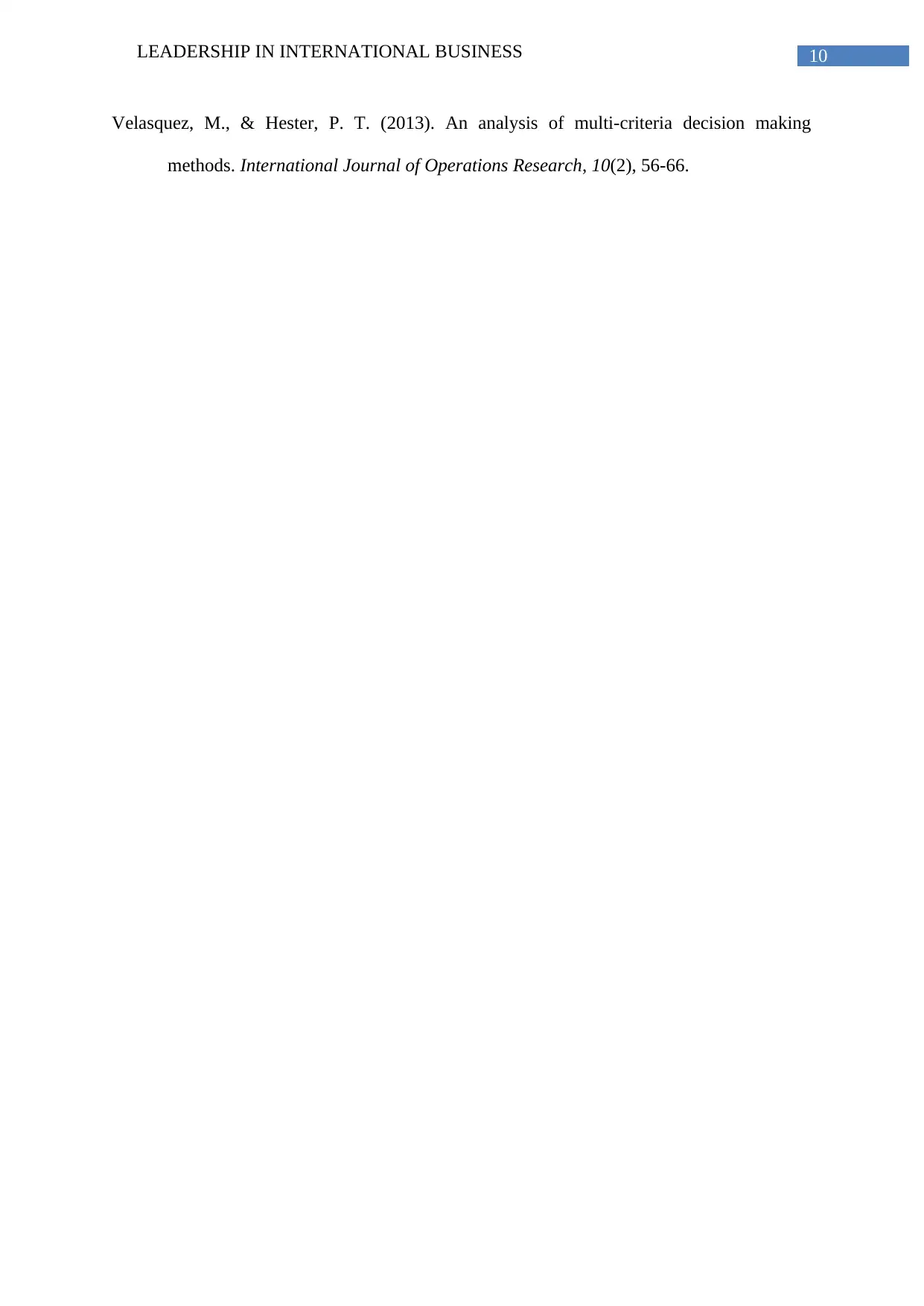
10LEADERSHIP IN INTERNATIONAL BUSINESS
Velasquez, M., & Hester, P. T. (2013). An analysis of multi-criteria decision making
methods. International Journal of Operations Research, 10(2), 56-66.
Velasquez, M., & Hester, P. T. (2013). An analysis of multi-criteria decision making
methods. International Journal of Operations Research, 10(2), 56-66.
1 out of 11
Related Documents
Your All-in-One AI-Powered Toolkit for Academic Success.
+13062052269
info@desklib.com
Available 24*7 on WhatsApp / Email
![[object Object]](/_next/static/media/star-bottom.7253800d.svg)
Unlock your academic potential
Copyright © 2020–2025 A2Z Services. All Rights Reserved. Developed and managed by ZUCOL.




